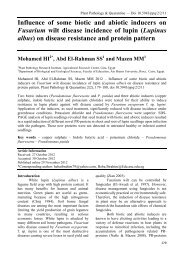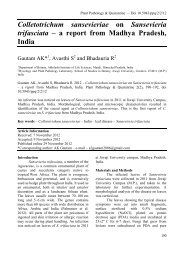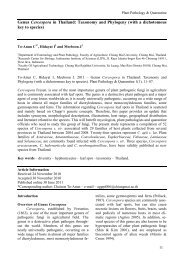Tropical phytopathogens 1 - Plant Pathology & Quarantine
Tropical phytopathogens 1 - Plant Pathology & Quarantine
Tropical phytopathogens 1 - Plant Pathology & Quarantine
You also want an ePaper? Increase the reach of your titles
YUMPU automatically turns print PDFs into web optimized ePapers that Google loves.
Fig. 3 – Pseudocercospora punicae on Punica granatum from leaf spots: 1–2. Lesions on host<br />
leaves (1. upper surface and 2. lower surface). 3. Caespituli. 4. Stromata with attached<br />
conidiophores. 5–8. Conidia. 9. Culture. Bars: 1, 2, 9 = 10 mm. 4–8 = 10 µm.<br />
Table 1 Conidial size and septation of Pseudocercospora punicae isolates/strains.<br />
Species<br />
Conidia References<br />
Septa Size (µm)<br />
Cercospora punicae = Pseudocercospora punicae 2–8-septate 25–85 × 2.5–5 Chupp (1954)<br />
Pseudocercospora punicae 2–8-septate 18–85 × 2.5–5 Hsieh & Goh (1990)<br />
Pseudocercospora punicae 2–6-septate 42–72 × 2–4 Present study<br />
The leaf spots and fruits caused by this<br />
fungal species lead to reduced harvest and<br />
quality. The conidial septation and size of<br />
Pseudocercospora punicae are shown in Table<br />
1.<br />
Additionally, we describe here a partial<br />
sequence of the large subunit LSU (rRNA gene<br />
of P. punicae. For this, the genomic DNA from<br />
fungal mycelium was isolated using the pro-<br />
4<br />
tocol based on Cai et al. (1999). The incomplete<br />
sequence of the LSU rRNA operon was<br />
then amplified using the primers LROR and<br />
LR5 and sequenced using the same primers by<br />
SinoGenoMax Company limited, China for<br />
sequencing. The sequence obtained was 771 bp<br />
and is deposited in GenBank (JN107998). This<br />
sequence information can be useful for phylogenetic<br />
study in future work.









